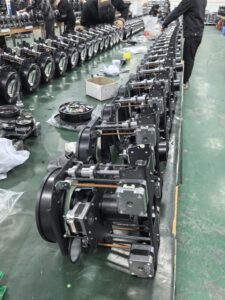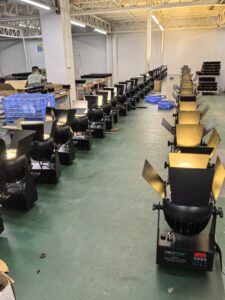How Moving Head Lights Are Made: Inside the Production Process
Moving head lights are essential in stage lighting, known for their flexibility, high brightness, and rich effects. Whether you’re lighting up a concert, theater, or club, understanding how these lights are manufactured helps customers recognize quality and reliability. In this blog, we’ll take you behind the scenes of the moving head light production process and show how top-quality stage lighting fixtures are built.
1. Product Design and Component Selection
Every professional moving head light starts with industrial-grade design. Engineers determine the light source (e.g., RGBW 4-in-1 LED, laser, etc.), lens structure, cooling system, and control features (like DMX512, pixel control, or auto-run modes). High-performance brands usually select durable components like OSRAM LEDs and aspherical lenses.
Keywords: moving head light design, LED stage light components, RGBW lighting
2. LED Module Assembly
The LED module is assembled in a cleanroom environment. Each LED chip is mounted on a PCB board with heat-conductive paste. After placement, the boards go through reflow soldering, followed by optical testing to ensure brightness, color accuracy, and beam uniformity.
Keywords: LED module production, RGBW LED light, stage light quality
3. Optical System Installation
Moving head lights require a precise optical system to deliver zoom, wash, and beam effects. Lenses, reflectors, and zoom motors are calibrated and mounted to ensure the correct beam angle range, often from 6° to 50°. Focus testing is conducted to check clarity at every zoom level.
Keywords: moving head zoom lens, stage light optics, beam and wash effect
4. Motor & Pan/Tilt Mechanism Assembly
The pan and tilt motors (typically stepper motors) are mounted with precision gears. This allows the moving head to rotate smoothly across a 540° pan and 270° tilt range. The movement speed is programmable via DMX.
Keywords: pan tilt motor, moving head rotation, DMX control light
5. Cooling System and Heat Management
LEDs and motors generate significant heat. High-quality moving head lights include aluminum heat sinks, cooling fans, and smart temperature sensors to prevent overheating and ensure a 50,000-hour lifespan.
Keywords: LED stage light cooling, long life moving head light
6. Programming and Firmware Installation
Technicians install firmware that controls lighting effects, movement patterns, and response to DMX signals. Built-in modes like strobe, color chase, or kaleidoscope effects are programmed at this stage.
Keywords: DMX lighting software, stage light firmware, built-in effects
7. Testing & Quality Control
Each unit undergoes strict aging tests, flicker tests, and motion calibration. Testing ensures that pan/tilt movements are smooth, zoom functions are accurate, and LED brightness meets standards. Units that fail are repaired or discarded.
Keywords: stage light quality control, moving head test, LED light factory
8. Final Assembly and Packaging
Once all components pass QC, the moving head lights are assembled and polished. Packaging includes foam protection and product manuals. Most are packed in cartons or flight cases, ready for global shipping.
Keywords: moving head light packaging, stage light export, LED light manufacturer
Conclusion
Producing a high-quality moving head LED light involves precise engineering, strict quality control, and expert craftsmanship. If you’re sourcing lights for a stage, club, event, or DJ setup, understanding this process helps ensure you choose reliable equipment that delivers powerful, long-lasting performance.


.jpg-scaled-e1749278160789-205x65.png)